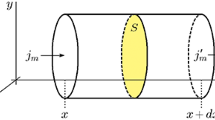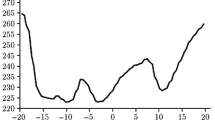Abstract
The chemical structure of HMX flame during combustion in air at a pressure of 1 atm was calculated using molecular beam mass spectrometric sampling. HMX vapor was recorded for the first time near the burning surface. A total of 11 species were identified in the HMX flame (H2, H2O, HCN, N2, CO, CH2O, NO, N2O, CO2, NO2, and HMX vapor), and their concentration profiles were measured. The HMX combustion was unstable. The species concentration profiles exhibit periodic pulsations related to variation in the HMX burning rate. The HMX flame structure at various distances to the burning surface was determined using the average value of the burning rate. Two main zones of chemical reactions in the flame were found. In the first zone ≈0.8 mm wide adjacent to the burning surface, HMX vapor decomposes and NO2, N2O, and CH2O react with each other to form HCN and NO. In the second zone ≈0.8–1.5 mm wide, HCN was oxidized by nitric oxide to form the final combustion products. The composition of the final combustion products was analyzed. The global reaction of HMX gasification at a pressure of 1 atm was established. Heat release values in the condensed phase calculated by the global gasification reaction and by the equation of heat balance on the burning surface (using literature data from microthermocouple measurements) were analyzed and compared.
Similar content being viewed by others
References
O. P. Korobeinichev, L. V. Kuibida, and V. Zh. Madirbaev, “Investigation of the chemical structure of the HMX flame,” Combust., Expl., Shock Waves, 20, No. 3. 282–285 (1984).
L. V. Kuibida, “Investigation of the flame structure of nitramines using molecular beam mass spectrometric sampling,” Candidate’s Dissertation in Phys. and Math., Novosibirsk (1988).
O. P. Korobeinichev, L. V. Kuibida, A. A. Paletsky, and A. A. Chernov, “Study of solid propellant flame structure by mass spectrometric sampling,” Combust., Sci. and Technol., 113–114, 557–571 (1996).
A. A. Zenin, “HMX and RDX: Combustion mechanism and influence on modern double-base propellant combustion,” J. Propuls. Power, 11, No. 4, 752–758 (1995).
A. A. Zenin, V. M. Puchkov, and S. V. Finyakov, “Characteristics of HMX combustion waves at various pressures and initial temperatures,” Combust., Expl., Shock Waves, 34, No. 2, 170–176 (1998).
A. Zenin and S. Finjakov, “Characteristics of octogen and hexogen combustion: A comparison,” in: Proc. of 37th Int. Annu. Conf. of ICT, Fraunhofer Institut Chemische Technologie, Karlsruhe, Germany (2006), pp. 118.1–118.18.
N. Kubota and S. Sakamoto, “Combustion mechanism of HMX,” Propellants, Explosives, Pyrotechnics, 14, No. 1, 6–11 (1989).
V. P. Sinditskii, V. Y. Egorshev, and M. V. Berezin, “Study on combustion of new energetic nitramines,” in: Proc. of 32th Int. Annu. Conf. of ICT, Fraunhofer Institut Chemische Technologie, Karlsruhe, Germany (2001), pp. 59.1–59.13.
T. P. Parr and D. M. Hanson-Parr, “Solid propellant flame structure,” in: Symp. Proc. of Materials Research Soc., Vol. 418, Pittsburgh (1996), pp. 207–219.
C.-J. Tang, Y. J. Lee, G. Kudva, and T. A. Litzinger, “A study of the gas-phase chemical structure during CO2 laser assisted combustion of HMX,” Combust. Flame, 117, Nos. 1–2, 170–188 (1999).
T. Parr and D. Hanson-Parr, “Solid propellant flame chemistry and structure,” in: K. Kuo and T. P. Parr (eds.), Non-Intrusive Combustion Diagnostics, Begell House, New York-Wallingford (1994), pp. 571–599.
T. Parr and D. Hanson-Parr, “Optical spectroscopic measurements of energetic material flame structure,” in: Overviews of Recent Research on Energetic Materials, World Scientific Publ., Singapore (2005). (Advanced Series in Physical Chem., Vol. 16.)
G. Lengelle, J. Duterque, and J. F. Trubert, “Physicochemical mechanisms of solid propellant combustion, solid propellant chemistry,” in: V. Yang, T. B. Brill, W.-Z. Ren (eds.), Progress in Astronautic and Aeronautic, Vol. 185: Combustion, and Motor Interior Ballistics, AIAA, Reston (2000), pp. 287–332.
T. Mitani and F. A. Williams, “A model for the deflagration of nitramines,” in: 21th Symp. (Int.) on Combustion, Combustion Inst., Pittsburgh (1986), pp. 1965–1974.
J. E. Davidson and M. W. Beckstead, “A three-phase model of HMX combustion,” in: 26th Symp. (Int.) on Combustion, Combustion Inst., Pittsburgh (1996), pp. 1989–1996.
V. N. Simonenko, A. B. Kiskin, V. E. Zarko, and A. G. Svit, “Special features of nitramine combustion at atmospheric pressure,” Combust., Expl., Shock Waves, 33, No. 6, 685–687 (1997).
V. N. Simonenko, V. E. Zarko, and A. B. Kiskin, “Characterization of self-sustaining combustion of cyclic nitramines,” in: Proc. of 29th Int. Annu. Conf. of ICT, Fraunhofer Institut Chemische Technologie, Karlsruhe, Germany (1998), pp. 169.1–169.14.
T. L. Boggs, “The thermal behavior of cyclotrimethylenetrinitrate (RDX) and cyclotetramethylenetetranitrmine (HMX),” in: K. Kuo and M. Summerfield (eds.), Progress in Astronautic and Aeronautic, Vol. 90: Fundamentals of Solid-Propellant Combustion, Academic Press, New York (1984), pp. 121–175.
“HMX Propellant Research Group. The fundamental study of HMX composite propellant and its practical application,” Tech. Report No. TR-875, National Aerospace Laboratory (1985).
N. E. Ermolin and V. E. Zarko, “Modeling of cyclic nitramine combustion (review),”Combust., Expl., Shock Waves, 34, No. 5, 485–501 (1998).
T. B. Brill and R. I. Hiyoshi, “Pyrolysis of energetic materials in inert vs. reactive atmospheres,” in: Proc. of 32nd Int. Annu. Conf. of ICT, Fraunhofer Institut Chemische Technologie, Karlsruhe, Germany (2001), pp. 14.1–14.12.
T. B. Brill, “Connecting molecular properties to decomposition, combustion and explosion trends,” in: Overviews of Recent Research on Energetic Materials, Chapter 1, World Scientific Publ., Singapore (2005). (Advanced Series in Phys. Chem., Vol. 16.)
R. R. Bernecker and L. C. Smith, “On the products formed in the combustion of explosives. Freeze-out the water-gas reaction,” J. Phys. Chem., 71, No. 8, 2381–2390 (1967).
O. P. Korobeinichev, “Study of energetic material combustion chemistry by probing mass spectrometry and modeling of flames,” in: Overviews of Recent Research on Energetic Materials, Chapter 3, World Scientific Publ., Singapore (2005), pp. 75–103. (Advanced Series in Phys. Chem., Vol. 16.)
O. P. Korobeinichev, L. V. Kuibida, A. A. Paletsky, and A. G. Shmakov, “Molecular beam mass spectrometry to ammonium dinitramide combustion chemistry studies,” J. Propuls. Power, 14, No. 6, 991–1000 (1998).
A. A. Paletsky, O. P. Korobeinichev, A. G. Tereshchenko, E. N. Tereshchenko, and P. D. Polyakov, “Flame structure of HMX/GAP propellant at high pressure,” in: 30th Symp. (Int.) on Combustion, Combustion Inst., Pittsburgh (2004), pp. 2105–2112.
R. Jr. Behrens, “Identification of octahydro-1,3,5,7-tetranitro-1,3,5,7-tetrazocine (HMX) pyrolysis products by simultaneous thermogravimetric modulated beam mass spectrometry and time-of-flight velocity-spectra measurements,” Int. J. Chem. Kinet., 22, 135–157 (1990).
V. R. Stepanov, A. A. Fedotov, A. N. Pavlov, and G. M. Nazin, “Mass spectrometric study of the elementary stages of thermal decomposition of cyclic nitramines,” in: Chemical Physics of Combustion and Explosion Processes, Proc. IX Symp. on Combustion and Explosion (1989), p. 100–103.
NIST Chemistry WebBook (http://webbook.nist. gov/chemistry/).
E. N. Volkov, A. A. Paletsky, and O. P. Korobeinichev, “RDX flame structure at atmospheric pressure,” Combust., Expl., Shock Waves, 44, No. 1. 43–54 (2008).
T. B. Brill, “Multiphase chemistry considerations at the burning surface nitramine monopropellants,” J. Propuls. Power, 11, 740–751 (1995).
E. S. Kim, V. Yang, and Y.-C. Liau, “Modeling of HMX/GAP pseudo-propellant combustion,” Combust. Flame, 131, 227–245 (2002).
N. Kubota, “Survey of rocket propellants and their combustion characteristics,” in: K. Kuo and M. Summerfield (eds.), Progress in Astronautic and Aeronautic, Vol. 90: Fundamental of Solid Propellant Combustion, Chapter 1, AIAA, New York (1984), pp. 1–52.
G. Krien, H. H. Licht, and J. Licht, “Thermochemische untersuchungen an nitraminen,” Thermochim. Acta, 6, No. 5, 465–472 (1973).
J. L. Lyman, Y.-C. Liau, and H. V. Brand, “Thermochemical functions for gas-phase, 1,3,5,7-tetranitro-1,3,5,7-tetraazacyclooctane (HMX), its condensed phases and its larger reaction products,” Combust. Flame, 130, 185–203 (2002).
R. J. Kee, F. M. Rupley, and J. A. Miller, “CHEMKIN-II: A Fortran chemical kinetics package for the analysis of gas phase chemical kinetics,” Sandia National Laboratories Report No. SAND 89-8009B (1989).
A. A. Ulanovskii, B. L. Shmyrev, and Yu. N. Altykhov, “Universal tungsten-rhenium heat convertres in hightemperature thermometry,” Pribory, 5, No. 4–13 (2006).
P. G. Hall, “Thermal decomposition and phase transition in solid nitramines,” Trans. Faraday Soc., 67, No. 578, Part 2, 556–562 (1971).
Yu. Ya. Maksimov, “Boiling point and enthalpy of evaporation of liquid RDX and HMX,” Zh. Fiz. Khim., 66, No. 2, 540–542 (1992).
D. M. Hanson-Parr and T. P. Parr, “Thermal properties measurements of solid rocket propellant oxidizers and binder materials as a function of temperature,” J. Energetic Mater., 17, No. 1, 1–48 (1999).
R. L. Shoemaker, J. A. Stark, and R. E. Taylor, “Thermophysical properties of propellants,” High Temperatures — High Pressures, 17, 429–435 (1985).
Author information
Authors and Affiliations
Corresponding author
Additional information
__________
Translated from Fizika Goreniya i Vzryva, Vol. 44, No. 6, pp. 26–43, November–December, 2008.
Rights and permissions
About this article
Cite this article
Paletsky, A.A., Volkov, E.N. & Korobeinichev, O.P. HMX flame structure for combustion in air at a pressure of 1 atm. Combust Explos Shock Waves 44, 639–654 (2008). https://doi.org/10.1007/s10573-008-0098-6
Received:
Revised:
Published:
Issue Date:
DOI: https://doi.org/10.1007/s10573-008-0098-6




